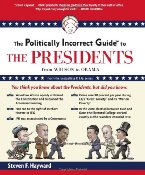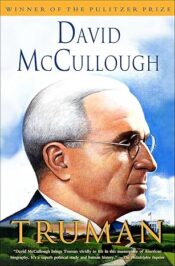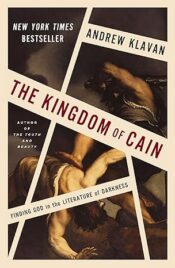
The Politically Incorrect Guide to The Presidents By Steven F. Hayward
 The Politically Incorrect Guide to The Presidents
The Politically Incorrect Guide to The Presidents
From Wilson to Obama
By Steven F. Hayward
Steven Hayward’s book captured this reviewer’s attention because it reflects my objection to the rating system used by Robert W. Merry in Where They Stand. Merry rated the presidents according to historians’ insights, electoral results and his own “test of greatness: whether the individual in the Oval Office “set the country on a new course.â€
Hayward rejects all three measures. (He also differs by beginning with Wilson, whereas Merry rated all the presidents.) Hayward’s single most important factor for evaluating presidents is “Does the president take seriously his oath of office ‘to preserve protect and defend the Constitution of the United States?†(Emphasis Hayward’s)
To answer that question Hayward assessed each president’s record – did he understand the Constitution and defend it from efforts to undermine or change its meaning, and were his Supreme Court nominees consistent with his oath of office. A letter grade is given each president accordingly. Readers will find informative sidebars on almost every page. Additional reading is suggested under the heading “A Book You’re Not Supposed to Read.†President’s quotes, lively comments and little known facts are also included.
Hayward begins with an historical perspective of how the political culture and the presidency changed over the years.
“In the nineteenth century, presidential candidates routinely talked about the Constitution in their campaigns, and most presidential inaugural addresses discuss the Constitution at some length.â€Â Today it rarely figures into presidential campaigns. Hayward implies that is as much an indication of neglect by presidents and would be presidents as it is their judgment that the topic no longer resonates with electorates untutored in the nation’s founding document.
It seems that textbook authors need not be overtly biased to shape public perceptions. Sins of omission are equally effective.
Amazingly you read through piles of college textbooks and historical surveys of the presidency without encountering a single mention of the president’s relationship to the Constitution or how president’s arguments and actions changed the way the Constitution is understood and operates.
As for the presidency itself, Hayward writes:
The modern presidency has become exactly what the Founders feared and opposed. Skeptics of the institution, such as the anti-Federalist author who wrote under the pen name of ‘Cato’ predicted that the office would come to be characterized by ‘ambition with idleness–baseness with pride–aversion to the truth-flattery-treason-perfidy-violation of engagements –contempt of civil duties–hope from the magistrates weakness; but above all the perpetual ridicule of virtue.
As has been suggested in other posts on this blog, the anti-Federalist’s were often prescient.
Democrat presidents generally fare poorly in Hayward’s ratings, but he does not spare Republicans who fail to measure up. Woodrow Wilson, not surprisingly, earns a solid F in Hayward’s grade book. Wilson openly criticized the Constitution, was contemptuous of Congress and thought the political philosophy that guided the American founding was defective. Wilson and other progressives did not perceive unrestrained government as a threat to liberty. Rather, they saw the state as the engine of constant improvement in human affairs and welcomed its expansion.
The author is much kinder to Warren G. Harding whom he describes as “the most underrated modern president.†He was in all respects the “anti-Wilson president.†Harding not only modernized a chaotic budgeting process, but he reduced government spending, cut top income tax rates from 73 percent to 46 percent and vetoed expenditures he viewed as constitutionally suspect. It is no wonder liberal academics disparage him.
Mostly ignored is that the Progressive Wilson was an unapologetic bigot who segregated the U.S. government and fired all the black postmasters when he took office in 1913; and Harding gets no kudos for being an early proponent of civil rights protection for blacks and for putting his words into action by appointing blacks to senior positions in the Departments of Labor and Interior.
Calvin Coolidge was even more the antithesis of Wilson than Harding. Coolidge understood that Progressive ideology and its ever-growing independent bureaucracy undermines both the rule of law and the American character.
In a 1922 speech to the American Bar Association he said:
This is not the government which was put into form by Washington and Hamilton and popularized by Jefferson…Behind very many of these enlarging activities lies the untenable theory that there is some short cut to perfection. It is conceived that there can be a horizontal elevation of the standards of the nation, immediate and perceptible, by the simple device of new laws. This has never been the case in human experience…
Under the attempt to perform the impossible there sets in a general integration. When legislation fails, those who look upon it as a sovereign remedy simply cry out for more legislation. A sound and wise statesmanship which recognizes and attempts to abide by its limitations will undoubtedly find itself displaced by that type of public official who promises much, talks much, legislates much, expends much, but accomplishes little.  (Emphasis Hayward’s)
One of the author’s sidebars reveals Coolidge as our most scholarly president. He read classical literature in the original Greek and Latin during the evenings as a form of relaxation. He was also the last president to write his own speeches.
FDR is identified as doing more than any other President to undermine the Constitution. This reviewer would argue that dubious distinction really belongs to the present White House occupant.
The chapter on Lyndon B. Johnson points out that his War on Poverty actually harmed the very people he claimed to help. It “destroyed the social capital that was holding together neighborhoods and families in some of the poorest parts of 1960s America.â€
If Harding and Coolidge were underrated, Hayward characterizes John F. Kennedy as the most overrated president. “The only modern president with less preparation for office than Barack Obama.†The true story of how he got the missiles withdrawn from Cuba, lauded as Kennedy’s triumph was, in fact, a political and strategic defeat for the United States. But then as now, a worshipful press covered up Kennedy’s actual performance to burnish the Camelot illusion. They continue to do so despite recent damning evidence of his incompetence and carelessness. In the interests of stimulating interest in Hayward’s book, you will have to read the book to learn more.
Hayward castigates Richard Nixon for his first term spending and regulatory excesses (The number of pages in the Federal Register grew 19% under Johnson but a staggering 121 percent under Nixon.) Hayward also provides background for Watergate, explaining why Nixon was so reviled by Democrats and why many Republicans were happy to get rid of him. Again, you’ll have to read the book “for the rest of the story.â€
Hayward’s assessment of Jimmy Carter can be summarized in this quote from Henry Kissinger:
The Carter administration has managed the extraordinary feat of having at one and the same time, the worst relations with out allies, the worst relations with our adversaries, and the most serious upheavals in the developing world since the end of he Second World War.
However, this reviewer suggests that Carter’s “trifecta’ may soon be overtaken by Obama’s Superfecta: enormous deficits, slow productivity growth, burgeoning entitlements, persistent unemployment and a foundering economy.
Hayward criticizes George H. W. Bush for squandering the Reagan legacy by increasing federal spending and regulation and for breaking his “read my lips’ no new taxes pledge. He is credited for his conduct of foreign policy, fulfilling the president’s primary constitutional duty of defending the nation. He gets a split decision on the Supreme Court for appointing David Souter, “one of the very worst Republican appointments ever made,†and for appointing one of the best, Clarence Thomas.
Hayward reminds us, as we witness media efforts to rehabilitate Bill Clinton, how corrupt his “two for one†presidency was. Hayward cites Bob Herbert of the New York Times for a concise description of the 42nd president.
“â€Some of Mr. Clinton’s closest associates and supporters are acknowledging what his enemies have argued for years–the man is so thoroughly corrupt it is frightening,’ wrote Bob Herbert of the New York Times. ‘The president who hung a ‘for rent’ sign on the Lincoln Bedroom also conducted a clearance sale on pardons†during his last days in the White House.
In the process of assigning grades Hayward manages to be both scholarly and entertaining. His combination of neglected and forgotten historical information with trenchant observations injects color into what otherwise might be dull reading. This book should be read because it is more than a “Politically Incorrect Guide to the Presidents.†It is a cautionary account of how Wilson’s dream of the unrestrained state guided only “by the exigencies and the new aspects of life itself†became today’s nightmare of profligate spending, crony capitalism, destruction of the rule of law, and, inevitably, failing a course change, bankruptcy and tyranny.
Reviewers Note: The Politically Incorrect Guide to the Presidents, is one of a series of Politically Incorrect Guides to topics hijacked by “politically correct historians, academia and the media.†I counted 21 Guides on the Regnery webpage. This is the first I have read but it won’t be the last.
 The posts are coming!
The posts are coming!


2 comments
Great review. Looks like a great book too.
[Reply]
Thanks Michael. It’s a perfect book for college students to read. They will not get any of the information from their textbooks.
[Reply]
Leave a Comment